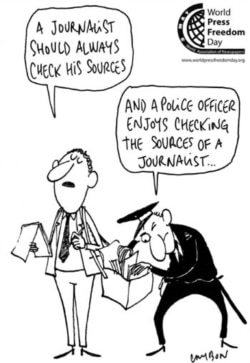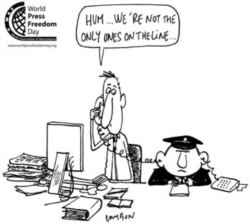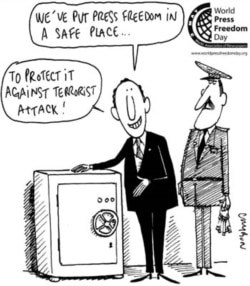On the far side of that Iron Curtain, a closed and repressive system of governance was rapidly taking hold, in which dissent was ruthlessly suppressed, economic life rigidly managed by communist authorities, and media used exclusively as an instrument of the state. It took decades for the Soviet experiment to collapse under the weight of its own contradictions, in an economic and political meltdown that ended the Cold War and brought the promise of greater freedom and openness to tens of millions of formerly captive peoples. Hopes ran high that these openings would permit all of the fundamental freedoms to emerge and flourish, including freedom of the press.
In fact, in the period immediately preceding the Soviet collapse and in its immediate aftermath, the flowering of open expression and a nascent independent press suggested a durable and institutionalized Fourth Estate might materialize.
The Soviet era's waning days saw the exertion from below of significant pressure for greater freedom of expression and a diverse and independent reporting of news. In most of the former satellite countries of Central Europe a free press rose from the ashes of what for 40 years had been known as the Eastern bloc. For the former Soviet republics, however, with the exception of the Baltic states, the promise of the opening in the late 1980s and early 1990s was short-lived.
New Methods To Achieve Old Results
Across most of the former Soviet Union today, an "information curtain" has descended that in some aspects differs from that of the Soviet era, but in important ways is imposing a no less repressive news-media environment.
Gone is the smothering, all encompassing ideological control across wide swaths of Europe and Eurasia. A more geographically circumscribed area -- Russia and most of the countries on its periphery -- now lies behind a new curtain that effectively shuts off the majority of people in these lands from news and information of political consequence. Today, methods for dominating news media are different, based on state-enabled oligarchic control, broadcast monopolies of presidential "families," and mass-media manipulation intended to create a veneer of democratic practice without its substance.
Unlike the Soviet era, some intrepid journalists now do manage to report independently. However, absent the rule of law and meaningful legal protections, the former Soviet Union is today one of the world's most dangerous places for journalists. Reporters willing to investigate issues such as political and corporate corruption are confronted by powerful vested interests that strive to muzzle news professionals. Intimidation, physical violence, and even murder of reporters and editors have become commonplace.
Journalists in virtually every former Soviet republic have been victims of contract killings or otherwise met death under suspicious circumstances. Russia, for example, has been a deadly place for journalists in both the Yeltsin and Putin eras. Since President Vladimir Putin assumed office seven years ago, at least two dozen journalists have been killed, including Paul Klebnikov, editor of "Forbes-Russia," who was shot nine times with a semiautomatic weapon on the street outside his Moscow office in July 2004; Anna Politkovskaya, an investigative journalist who wrote for "Novaya gazeta," who was executed in the elevator of her apartment building in October 2006; and Ivan Safronov, a defense correspondent for the "Kommersant" newspaper, who in very unclear circumstances plunged to his death from his apartment building in Moscow in March. Rarely are serious investigations pursued or perpetrators brought to justice. Impunity is the standard.
To ensure regime security and shield from public view all-pervasive official corruption, the post-Soviet authorities seek to limit scrutiny of their decisions and activities by silencing the independent press.
Entertaining, But Not Informative
This modern variant of media control is a more sophisticated, distant cousin of the raw and overweening institutional censorship of the Soviet era. The stodgy, Soviet era broadcasting diet has in large measure been cast aside. Today, modern media fare, rich in entertainment and news programming of high technical quality and production values are staples, especially in Russia. While the contemporary media menu in Russia offers a wide assortment of entertainment options, it for the most part excludes alternative views and analysis on news and public affairs, particularly where it counts most, on national television broadcasts, from which most citizens continue to get their information.
All of Russia's major national television channels -- RTR, Channel One, and NTV -- are now effectively state controlled. Commenting on the troubled condition of Russia's news media, former Soviet President Mikhail Gorbachev observed: "The one thing I can say is that it's pointless today to watch television [in Russia]."
Putin's tenure has seen a systematic muzzling of independent reporting. Current methods of news media control rely on the imposition of state ownership on media companies whose editors are replaced by Kremlin supporters. Gazprom-Media, an arm of the state-controlled gas behemoth, has taken control of a number of previously independent news outlets and either closed their doors or summarily abolished independent reporting. Today, journalists at the Russian News Service, Russia's largest nonstate radio network (owned by businesses close to the Kremlin), work under a "50 percent rule" imposed by station management to ensure that at least half of the network's total reporting on Russia is "positive."
The repressive media landscape in the former Soviet Union is illuminated by findings from "Freedom Of The Press 2007," Freedom House's annual survey of global media independence. The Russian authorities are not alone in forging a media environment that filters out critical voices. The survey's most recent findings show that 10 of the 12 CIS states are ranked "Not Free," indicating these countries do not provide basic guarantees and protections in the legal, political, and economic spheres to enable open and independent journalism.
Moving In The Wrong Direction
Of the 10 Not Free countries, none is moving in the direction of more freedom and most have a decidedly downward trajectory. Of the 193 countries examined in the survey, three of the 10 worst press-freedom abusers --Belarus, Uzbekistan, and Turkmenistan -- are in the former Soviet Union.
The Internet has emerged as the principal alternative and challenger to media hegemony in the former Soviet Union. Despite the authorities' dogged efforts to control it, the Internet and other news media set today's Soviet successor states apart from their Cold War ancestor. Blogs are stimulating debate and discussion, and domestic and foreign news websites offer an alternative to state-controlled or -influenced news outlets. However, while the Internet holds further promise and connectivity is growing at an impressive rate, it remains a medium through which only a small fraction of news is obtained. It is also fast becoming a target of greater interest for new regulatory intervention by the authorities.
Through a revitalized crackdown on press freedom, post-Soviet leaderships have managed to draw the media back under control. Only a decade and a half after the end of the Cold War, freedom of the press for tens of millions of people across the former Soviet Union has come nearly full circle. In post-Soviet states that suffer from ill-conceived policies, entrenched corruption, and unaccountable governance, denial of the indispensable role played by the free press in allowing critical scrutiny is bound to delay, possibly indefinitely, progress toward true and vibrant democracy.
Christopher Walker is director of studies at Freedom House. Freedom House's annual survey of global media independence, "Freedom Of The Press 2007," was released on May 1.
World Press Freedom Day
 (WAN/Cambon)
(WAN/Cambon) (WAN/Cambon)
(WAN/Cambon)
 (WAN/Cambon)
(WAN/Cambon) (WAN/Cambon)
(WAN/Cambon)RELATED ARTICLES
Threats To Press Freedom Growing More Severe
CIS Press Freedom Suffers Continued Decline
Pressure Mounting On Russian Opposition, Media
Uzbek Government Increases Its Blocking Of News Websites
ARCHIVE
To view an archive of RFE/RL's coverage of media-related stories, click here.
















